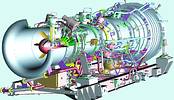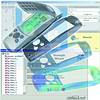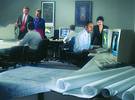Unigraphics NX 2: the next generation
October 2003
Information from Esteq Design

The merger of SDRC and Unigraphics saw the amalgamation of much more than just the Unigraphics and I-DEAS products, with a great deal of technology being available from the likes of the Imageware products (such as Surfacer), which SDRC acquired back in 1998. While under SDRC’s control, Imageware Surfacer had remained a purely standalone system providing its specialist functionality, in terms of freeform surface modelling and point cloud handling, to its users with only the most basic form of integration with I-DEAS. So, it seemed that under the NX roadmap, things would become far more integrated – which they have with the NX 2 release.
What EDS has done is take the freeform surface modelling technology from the Surfacer product and integrate it into the core of Unigraphics' existing surface modelling. For those without experience of the two products or surfacing in general, this may sound a bizarre move, so perhaps a little explanation is in order. Essentially, there are two different methodologies within the surface modelling camp. One side relies on the use of networks of curves to define surface boundaries and existing geometry to further define the transitions between surfaces - this has the benefit that in many systems, any changes made to those underlying curves can be propagated through the surfaces to update the model as a whole. And this is the area in which Unigraphics has always excelled. The other side is freeform surface modelling, where the user typically starts with a flat, planar surface and manipulates the various controls (such as control points/vertices, isoparms, etc) to 'sculpt it' into the desired form. While this allows the user to freely experiment with form, it does have the disadvantage that all changes must be made in the same way - ie, manually. And as one might have guessed, this is Imageware Surfacer's particular speciality. What the NX 2 release sees is the integration of both methods of surfacing into the core of Unigraphics but with a few rather neat extras as well.
As said at the outset, much of the work in the initial NX release was to evolve the Unigraphics interface to bring it more inline with current interface standards and methods of design. But more than that, NX 1 saw the reworking of existing functions to make them both more efficient, and in the case of features such as the 'always accessible' navigator, make their use a great deal more effective. This work has continued through into NX 2, with all new or reworked features and functions being given a much more consolidated feel, allowing the user to access all of the commands, options, and variables from within single dialog boxes. Perfect examples of this are the greatly redesigned surfacing functions, in particular, those based on the freeform modelling functionality from Surfacer.

From within the single X-Form dialog, users have the ability to experiment with, and control the form of, explicit surfaces with great precision, and create the form required, whether that is in a fully freeform mode, or using a point cloud or a number of sections as a reference point. Control points and isoparms can be manipulated freely (in terms of translation and rotation) in a drag-and-drop manner (including the ability to use some form of reference, such as an axis), or moved to specified points using numerical inputs. There are also tools that allow the user to precisely control those portions of a surface that they want to manipulate and of course, those they do not. There are a number of enhancements related to the integration of surfacer functions, such as improvements made in the Match edge operation (pretty self explanatory) and the Mirror Display functions. This is commonly available in surface modelling tools and it allows users to define and work with just one half of a symmetrical model (such as a car), with the system handling the display of the other half. The idea is that to make the process more efficient, one simply works on one half, then when the time comes to define the other half (perhaps one needs to define a feature which only appears on one side), one can actually create the geometry of the other side. This of course can also be used outside of the surface modelling environment and can be used to build up assemblies, etc, in a much more efficient manner (and its also backed up with the new mirrored feature, which is discussed further on in this passage).
To complement this, the previewing and diagnostics capabilities have also been improved and made a great deal more dynamic. For example, surface diagnostics (such as different shading types, curvature combs, sections) are stored as a separate entity within the feature tree, so they can be referred to either later on in the design process, or indeed, by another user picking up that same model. But the really clever surfacing enhancements are not related to user-interface, but rather to the manner in which surface modelling has been made much more intelligent.
The difficulty with the majority of freeform surface modelling tools is that while users have the ultimate tool for creating highly complex and sculpted forms, they do so without much in the way of 'editability' - each change and subsequent changes must be updated manually. What EDS has done is to take the history and feature-based model recording approach that is now mainstream within the solid modelling world, and apply it to freeform surface modelling. This means that each surface creation, modification and manipulation is recorded in a feature tree, stored in a fly-out navigator window. It also stores the manner in which you interconnect and blend between surfaces, apply blends, etc. The result is a mixture of a large quality of flexibility in terms of the manner in which you create surfaces, but that can also be edited in a formal, much more automated manner, with changes propagating throughout the whole model.
Modelling information
On the subject of the navigator windows and, in particular, its use as the window into the structure of both parts and assemblies, the Part Navigator has been enhanced in two interesting ways for this release. There are two new collapsible windows which firstly provide a preview of the feature, part or sub assembly one has selected and, secondly, allow the user to view the dependencies of that particular entity. By dependencies, we mean one can explore items that 'use the selected object (children) or items on which they depend (parents)'. This is the kind of information that is critical to the design process, particularly when editing complex models, but is often not available outside of a document management system.
Assembly modelling
Within the NX 2 release, assembly modelling has not seen that much development work, but what as been done will make the process both more intelligent and efficient. In the first instance, this is through the introduction of assembly arrangements. Essentially, this provides the ability to store different positions of a single product assembly. In many other CAD systems, these are referred to as configurations but in Unigraphics parlance, configurations are something else, so they are called arrangements. This is useful when one is trying to communicate and store the position of either a complex assembly or a number of individual sub-assemblies at critical stages in that product's operation. These different positions can then be used in downstream processes, such as FEA, visualisation, animation, etc and can be shown in drawings although it was not clear whether or not one can show two different positions with a single drawing view (which is useful if you are showing the maximum and minimum position of particular components).
Another area that has seen much work is the ability to mirror an assembly. This is done using a plane as a central mirror point. If the job in hand is a simple case of mirroring everything and creating a new set of handed components, then the process is simple. Where the real difficulty traditionally comes in is when one has to create a mixture of handed components and a number of parts that are simply re-used. Unigraphics handles this using a simple wizard style approach to the process. The user has the ability to define how each component is handled in terms of referencing, handed version creation or repositioning. It also accounts for the fact that while repositioned parts are just referenced versions of another part, handed versions are a distinct entity (and need a new part description) and it allows one to reflect this in the bills of materials and, should the user be using one, within the document management system as well.
Visualisation
Alongside the modelling enhancements made in this release, there has also been a lot of work done on improving the usability of Unigraphics' visualisation capabilities -- and this has been through the implementation of templates and pre-setup environments, combined with increased use of the navigator panels. The concept behind this work is to provide those users without a great deal of expertise in rendering and animation, the ability to quickly create decent images and animations which can then be used as communication aids, etc. As ever, the Unigraphics rendering tools are based on the LightWorks rendering engine and the users are provided with a large number of standard materials, etc. Of course, these can be extended to include their own, as well as allowing one access to any other materials stored in the LightWorks specific format. The way in which it works is simple. From the appropriate Navigator bar at the right of the screen, the user simply selects the item they want to apply and drag it onto the appropriate part. In the case of using environments to define a surrounding area for a product model, then one can simply drag a pre-set environment into the modelling window and 'you are away'. Of course, one may need to adjust the various items for scale, etc and this is done very easily using simple, on screen drag handles and dialogs. If the user is an experienced and regular user of the rendering tools in Unigraphics, then they still have the ability to dig in and fine tune the output imagery as one normally would.

Drafting
Although the first NX release saw both a lot of enhancements to the user interface and new modelling tools, one would imagine that, for many users out there, the real benefits were gathered from the changes and upgrades made in the drafting environment. A great deal of intelligence was added which made the creation of drawings semi-automated. The advantage that this had was that the grunt work of laying out drawing views, sections, details, etc, was automated through the use of templates which allowed the user to define commonly used layouts over and over again. The user could then concentrate on the important work of ensuring that the design, engineering and manufacturing information was present, such as annotation, GD and T, etc. This work has been continued and is reflected in the NX 2 release, which sees the introduction of a number of key new functions and features that will make the process even more efficient. For example, all manner of items that appear on drawings as standard within an organisation, can be stored in a library and dragged from the appropriate Navigator panel. These could include text files containing standard information (such as disclaimers and confidentiality details), corporate logos etc.
For more information on how Unigraphics NX for Total Product Engineering can enhance the full range of your product and process development applications from concept engineering through product design combining digital simulation right to manufacturing engineering, contact Henk Viljoen, Esteq Design, 012 991 5570 or visit www.esteq.com
Others who read this also read these articles
A challenge for motor manufacturers
Computer-based integration of design and manufacturing is essential for the '24-month car' to be achieved[ October 2004 ]
Prominent new lifestyle centre for Cape Town's financial district
Dimension Modeling created the 3D interior models that were then also rendered out for internal views of the apartments as well as the atrium and foyer areas[ August 2004 ]
Anglo Platinum - automating repetitive design tasks with Solid Edge
Solid Edge Insight is an innovative solution that seamlessly integrates CAD, design management and Web-based collaboration into a single tool that is easy to implement and easy to manage[ June 2004 ]
Styled plastic products and packaging - main pains and solution initiatives
To put the product and the customer front and centre, where they belong, all disciplines must sit at the same virtual table, sharing the same information and seeing the same vision[ June 2004 ]
Evolution from 2D to 3D - a product development manager's perspective: Part II
Whereas 2D CAD shortens time scales to some extent, 3D CAD goes much further, directly supporting the whole product development cycle, speeding up every activity and increasing the quality of design by removing many sources of inaccuracy and error[ April 2004 ]
Multiphysics analysis to simulate cylinder head
Adiabatics Inc used multiphysics FEA software from Algor to study the thermal and structural behaviour of a cylinder head for a diesel engine that would provide reduced heat rejection and increased power density while maintaining its superior fuel economy and lower operating cost[ December 2003 ]
Geopak helps create Festival City
Geopak Site allows one to handle with ease live 'what if' scenarios with the client and other design team members[ August 2003 ]
Desktop product has new features and enhancements
Engineers can accurately and quickly simulate one body rolling or sliding on another body, in three dimensions such as in cam and latch designs[ August 2002 ]
Others who read this also read these news items
Lockheed Martin selects preferred MCAD tool
[ December 2005 ]
Grand scale initiatives at Ethekwini Municipality
[ October 2005 ]
Robert Mugabe Avenue in Windhoek gets extension
[ August 2005 ]
Strand7 nonlinear analysis used to solve bracket deformation problem
[ August 2005 ]
Scania optimises truck components
[ February 2005 ]
Delcam's PowerMILL chosen for A1 Grand Prix engine manufacture by Zytek
[ February 2005 ]
A first of its kind: irrigation development, a R3,7-billion SADC project
[ February 2005 ]
Arup lands Tianjin Olympic Aquatic Centre project
[ December 2004 ]
Others who read this also read these regulars
Search Site
Subscribe
Previous Issues
Other Technews Publications
Other Technews Buyers Guides
 |  | Copyright c1995-2009 Technews Publishing (Pty) Ltd.. All rights reserved. |